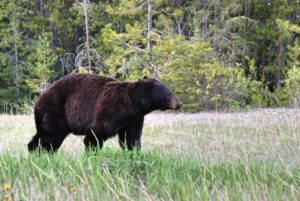
Black bears are as Appalachian as moonshine and fiddle music, and most anyone who has lived here has a bear story. In fact, most folks who visit our mountain hollers and trails have a bear story, even if it’s just a chance sighting from the road. They are fascinating animals. Their size and lumbering gate, their slow reactions to gawkers and photographers, make them seem docile and approachable, even cuddly. Yet they are incredibly fast and agile, and, when angered or threatened, downright horrifying.
My own bear story happened in the first two weeks I moved here. I was a seventeen-year-old freshmen at Maryville College, in Maryville, Tennessee, and I signed up to take a five-day hike on a section of the Appalachian Trail as part of the newly established Mountain Challenge program. We numbered about seven students and two experienced guides, one of whom was the founder of the program, Bruce Guilliaume.
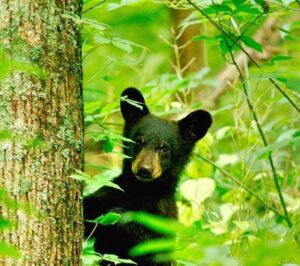
A couple of days into our hike, we settled at one of the lean-to shelters established along the trail for hikers. This structure had a chain link fence across the front, to protect us from any wild beasts. We’d set up camp and were digging into supper when a young cub wandered into the clearing. It was cute and curious, though it didn’t get too close. While we were all enchanted, our guides made a ruckus to drive it off. Bruce noted that wherever such a cub roamed, Momma Bear wasn’t too far off. We were all vigilant for the rest of the evening.
Sometime in the middle of the night, it got interesting. (This was before cell phones, and only the guides had timepieces. So, all I knew was it was dark and we were all sleeping.) We were awakened by the sound of a nylon backpack sliding and a thump as it hit the floor. Out came the flashlights, and we were greeted by the shining eyes of . . . Momma. She was pacing along the fence, sniffing, and very interested in whatever we had with us inside. All our gear, along with our garbage, was with us inside the enclosure. And, while she wasn’t huge, as bears go, it was abundantly clear that the fence across the front was only effective against small animals, and any illusion of safety we might’ve felt evaporated. If that bear wanted inside, she could go through the barrier with very little effort.
Fortunately, she’d simply followed her nose to our stash, much like her cub did earlier, and wasn’t really agitated. After about fifteen minutes of noise and commotion from inside the shelter, she wandered off in search of easier pickings. There was a lot of adrenaline and excitement on our side of the fence, and it was a while before we got back to sleep. Our encounter was certainly one of the most memorable moments of the hike, and very much a “Welcome to the Smokies” moment.
Thinking back after all these years, I don’t recall any sense of fear, no real sense that we were being threatened by her. I attribute that largely to our guides’ knowledge and experience, to understanding the heart of the encounter, and an appropriate response. The lesson we learned was that we were visitors to their home and needed to treat them with respect and understanding, like any good guest.
Our black bear, or Ursus americanus, also known as the American black bear, is found throughout North America, from Alaska to northern Mexico, and from coast to coast. According to the National Wildlife Foundation:
Because of their versatile diet, black bears can live in a variety of habitat types. They inhabit both coniferous and deciduous forests, as well as open alpine habitats. They typically don’t occur on the Great Plains or other wide-open areas, except along river courses where there is riparian vegetation and trees. They can live just about anywhere they can find food, but largely occur where there are trees.
While predominantly black, their color can vary depending on where they live. In the West they can be found with a rusty cinnamon color, and, in some Canadian areas they are a blue-gray or white.1)The blue-gray bears are found in southeastern Alaska, while the white bears are found in southern British Columbia “and are known as “spirit bears” by some indigenous cultures of the region.” National Wildlife Foundation Our Appalachian version is, of course, shades of black to dark brown.
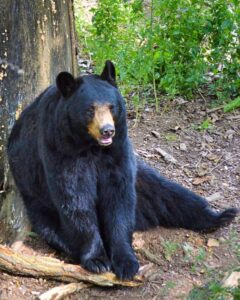
The average length of an adult is between four to six feet or longer. An adult weighs anywhere from 130 to 660 pounds. The largest males reach up to 6.6 feet and 900 pounds. Males are far larger than females, who tend to top out around 200 pounds, though size is determined by the abundance, or scarcity, of food. They can live up to thirty years, but most die before twenty. 2)Statistics found in the Encyclopedia Britannica.
The black bear figures prominently in most Native American myths and legends. Not surprising, really. The number of bear that roamed the continent was once great.3)Bear re-population work has been very successful, bringing the estimated numbers to between 850,000-900,000. They have been removed from the endangered species list. Bears provided sustenance, as well as oil and grease, materials for shelter, clothing, tools, and weapons for the clan.4)Myths of the Black Bear
The Cherokee tribe has seven clans, one of which is the Blue Clan. The Blue Clan is further subdivided into “Panther or Wildcat and Bear, which is considered the oldest clan. This clan produced people who were able to make special medicines for children.”5)The Cherokee Phoenix One of the better known Bear stories among the Cherokee is the Origin of the Bear, involving the mythical Ani-Tsa-gu-hi clan. The tale begins when a boy leaves the hunger and toil of his clan to live in the wild with the Bear, who have plenty. He convinces his family to join him, and, after fasting seven days, they all head out into the woods. When people in other towns tried to change their minds, the Ani-Tsa-gu-hi said,
We are going where there is always plenty to eat. Hereafter we shall be called yanu (bears), and when you yourselves are hungry come into the woods and call us and we shall come to give you our own flesh. You need not be afraid to kill us, for we shall live always.6)From James Mooney’s History, Myths, and Sacred Formulas of the Cherokees, originally published in 1888
You can read the full story of the Origin of the Bear here. Another Cherokee bear legend I found is The Bear Man.
The black bear’s history and resurgence have proven it to be a symbol of strength, caring, and resilience. It is making a comeback and is no longer an endangered species. Its range will never return to what it once was; humans have urbanized far too much of its habitat, but the black bear is thriving. The spread of residential development into what used to be remote hollers and bear country has caused increased contact and conflict between humans and bears. Organizations like the Appalachian Bear Rescue are actively working to mitigate the conflicts and return bears to the wild.
I see reports and videos of bears and other creatures walking into residential neighborhoods, and even inside homes. I can’t help but wonder why everyone is so surprised Bears don’t read signs, don’t recognize property boundaries, and a fence isn’t really a barrier to them (more of a mild suggestion). I have seen people with young children in Cades Cove and the Great Smoky Mountain National Park walk right up to bears, often a bear family with mother and cubs, and I hold my breath, waiting for the worst. Fortunately, I haven’t witnessed that. But I implore anyone visiting, moving into our hollers, and hiking our trails, if you encounter the black bear, take a picture, but keep your distance, be respectful, and understand a very important point: They were here thousands of years before us.
For more reading:
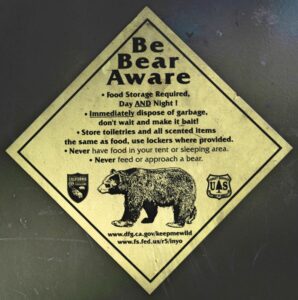 https://www.nwf.org/Educational-Resources/Wildlife-Guide/Mammals/Black-Bear
https://www.nwf.org/Educational-Resources/Wildlife-Guide/Mammals/Black-Bear- https://www.nps.gov/subjects/bears/managing.htm
- https://appalachianbearrescue.org/
- https://theblueridgehighlander.com/Cherokee-Legends-of-the-Black-Bear.php
- https://archive.org/details/jamesmooneyshist0000moon/mode/2up?q=%22Origin+of+the+Bear%22
- https://bear.org/bear-facts/black-bears/basic-bear-facts/
- https://www.britannica.com/animal/black-bear
**Featured image: Black bear at Cades Cove, TN (GSMNP), ZachN 0421 – Wikimedia
***Gallery images from Brent Moore, flickr
References
| ↑1 | The blue-gray bears are found in southeastern Alaska, while the white bears are found in southern British Columbia “and are known as “spirit bears” by some indigenous cultures of the region.” National Wildlife Foundation |
|---|---|
| ↑2 | Statistics found in the Encyclopedia Britannica. |
| ↑3 | Bear re-population work has been very successful, bringing the estimated numbers to between 850,000-900,000. They have been removed from the endangered species list. |
| ↑4 | Myths of the Black Bear |
| ↑5 | The Cherokee Phoenix |
| ↑6 | From James Mooney’s History, Myths, and Sacred Formulas of the Cherokees, originally published in 1888 |
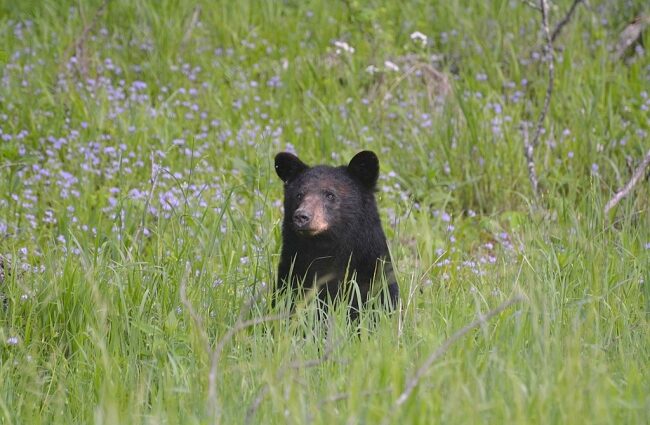




Thanks for the bear story and interesting black bear facts. Asheville has a large population black bears, some of which are equipped with tracking collars for an ongoing urban bear study. We’ve had at least a dozen visits to our backyard in North Asheville over the years. I routinely encounter bears on my bike rides and runs around the neighborhood and up to the Blue Ridge Parkway. The bears have become increasingly more brazen and nonchalant around humans. I give them plenty of respect, and despite some very close encounters, have not met with an aggressive bear (yet). My biggest fear is inadvertently running into (literally) one. I’ve dodged a few on blind curves and have been surprised by sudden appearances. A few humans and/or dogs in the area have not been so lucky, because they were in a situation where the bear felt threatened and responded accordingly.
Great article about the Black Bear!
Thank you Tom! I’m so glad you enjoyed it.
Thank you Jim, I’m glad you enjoyed it. It’s always good to hear your perspective. Your experiences and the unfortunate encounters are definitely a concerning result of the increased socialization of bears with urban expansion. They aren’t territorial, have an average range of between 70 and 80 square miles, and clearly are hard to keep contained. They’ve adapted very quickly to their human neighbors indeed, and don’t seem to pay us much mind, until they do. I’m not sure what kind of solution their might be, but please keep safe and I hope you continue to have good luck. Best regards.